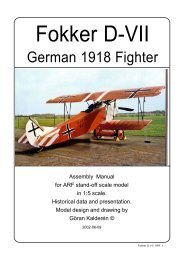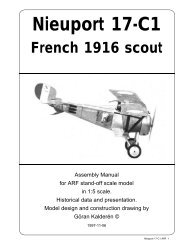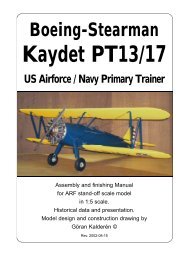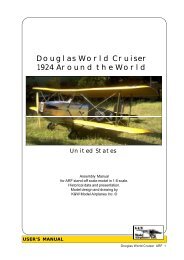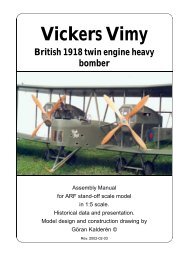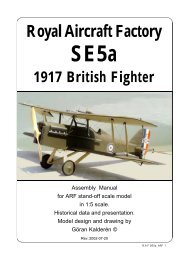Download PDF Manual - Macca's Vintage Aerodrome
Download PDF Manual - Macca's Vintage Aerodrome
Download PDF Manual - Macca's Vintage Aerodrome
- No tags were found...
You also want an ePaper? Increase the reach of your titles
YUMPU automatically turns print PDFs into web optimized ePapers that Google loves.
Bristol Fighter F2BFor the British aircommand it becamein 1916 obvious that a replacement for the slowand vulnerable BE2 series of aircraft was badlyneeded. Bristol at this time had designed a 2seater airplane of girder box design. To overcomethe restricted forward view for the pilot theupper wing was placed only 1 foot above thefuselage. The pilot’s line of sight was obstructedonly by the mere airfoil section thus renderinggood visibility forward/upward and forward downward.The necessary distance between wingplanes was obtained by moving the lower wingdownward under the fuselage. The first productionaircraft were designated F2A but when putin service as a reconnaissance aircraft, the oldtactics were used and the plane became easyprey for the opponents.A revised model F2B fighter/reconnaissancewith improved 275 hp. Rolls-RoyceFalcon engine and fighter tactics applied, becamea tremendous success. This engine is liquidcooled and the radiator first deployed as sidemounted, soon was changed and located upfront giving the nose a characteristic outline.The armament was a Vickers .303 machine gunmounted under the hood and shooting synchronizedto fire through the propeller arc through around outlet in the upper part of the radiator. Forthe observer there was a Lewis machine gunmounted on a Scarff ring mount.As production increased during 1917 itbecame difficult for Roll-Royce to keep up withdemand and other engine alternatives were triedand employed.That this was a very successful aircrafttype shows in that more than 4700 aircraft wereproduced and that that production continued longafter the war had ended. The aircraft saw actionin many foreign countries and was used by theBritish in their overseas operations.As production of the F2B increased inspeed during the mid-Summer of 1917, additionalRoyal Flying Corps squadrons wereformed or re-equipped with the new Bristolfighter. The production F2B featured a reducedchord tail plane with longer span elevators. Thesewere later changed to use the elevators of theF2A with the tail plane of the F2B and this arrangementwas retained for all wartime F2Bs.The F2B benefited from the lessonslearned from the first combat use of the F2Avariants. When introduced in combat they wereflown in action using single seat fighter tactics,which immediately proved successful.The aircraft was armed with a single synchronized.303 Vickers machine gun with 963rounds of ammunition in the nose for the pilotand a .303 Lewis machine gun for the observerwith seven 97 round ammunition drums. Someaircraft were upgunned in the field with an additionalLewis gun mounted over the wing to augmentthe forward firepower and twin Lewis gunsin the rear cockpit mounted on a Scarff ring.The increased production rate at Bristol’sfor the F2B resulted in a shortage of enginessince Rolls-Royce was unable to keep pace withthe demand for Falcon engines As a result, alternativeengines were examined and tested;including the Siddeley Puma, Hispano-Suiza 200hp. Hispano-Suiza 300 hp and the 200 hp SunbeamArab. The Sunbeam Arab being finallychosen, although others continued to be testedsince the Arab equipped variants provedto be somewhat under-powered. The installationof the Arab engine altered the nose contoursand exhaust stack arrangement.Before the end of the First World War,the Bristol fighter was to see service in varioustheaters of war, including with No 139 in Italy andNo 67 (Australian) Squadron in the Middle EastNos. 33, 36, 39, 76 and 141 Squadrons usedBristol Fighters for home defense duties.F2Bs used by home defense units as night fighterswere modified in a number of ways. Somewere fitted with navigation lights on the lowerwing tips and rudders, Holt flare brackets beneatheach lower wing tip and illuminated gunsights. Other night fighters were fitted with additionalforward firing machine guns. One aircraftof No 39 Home Defense Squadron had two Lewisguns fitted over the wing in addition to its normalsingle Vickers gun and twin Lewis guns for theobserver.By November of 1918 over 5,500 Bristolfighters, mainly F2Bs, had been ordered and, ofthese, 3,101 had been taken into the RFC andRAF. Although the Armistice led to cancellationof some orders, the “Biff” as it was known towartime airmen, continued to be manufactureduntil September of 1919, with a total of 4,747being produced.Documentation is available in Bristol Fighterin Action, Aircraft # 137 by Squadron/signal PublicationsInc., 1115 Crowley Drive, Carrolltown,Texas 75011-5010, USA, ISBN-0-89747-301-9.Bristol Fighter by JM Bruce, Albatros ProductionsLtd., 10 Long view, Berkhamsted, Herfordshire,HP4 1BY, Great Britain. ISBN -0-948414-85-5.Bristol F2B Fighter ARF 2



